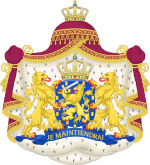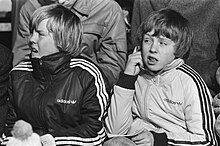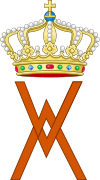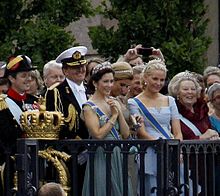| Revision as of 02:25, 1 May 2013 editGidonb (talk | contribs)Autopatrolled, Extended confirmed users95,957 edits disambiguating← Previous edit | Revision as of 03:30, 1 May 2013 edit undo107.212.88.39 (talk)No edit summaryTag: possible BLP issue or vandalismNext edit → | ||
| Line 3: | Line 3: | ||
| {{Infobox royalty | {{Infobox royalty | ||
| | honorific_prefix = His Majesty | | honorific_prefix = His Majesty | ||
| | name = Willem-Alexander | | name = Willem-Alexander The Cookoo Head Blah | ||
| | honorific suffix = OSJin QBIM | | honorific suffix = OSJin QBIM | ||
| | image = Willem-Alexander, Prince of Orange.jpg | | image = Willem-Alexander, Prince of Orange.jpg | ||
Revision as of 03:30, 1 May 2013
| This article is about a person involved in a current event. Information may change rapidly as the event progresses, and initial news reports may be unreliable. The last updates to this article may not reflect the most current information. Please feel free to improve this article (but note that updates without valid and reliable references will be removed) or discuss changes on the talk page. (April 2013) (Learn how and when to remove this message) |
King of the Netherlands
| Willem-Alexander The Cookoo Head Blah | |||||
|---|---|---|---|---|---|
 Willem-Alexander, 2009. Willem-Alexander, 2009. | |||||
| King of the Netherlands (other titles) | |||||
| Reign | 30 April 2013 - present | ||||
| Predecessor | Beatrix | ||||
| Heiress apparent | Catharina-Amalia | ||||
| Born | (1967-04-27) 27 April 1967 (age 57) Utrecht, Netherlands | ||||
| Spouse | Máxima Zorreguieta Cerruti (m. 2002) | ||||
| Issue Detail | Catharina-Amalia, Princess of Orange Princess Alexia Princess Ariane | ||||
| |||||
| House | House of Orange-Nassau (modern) House of Amsberg | ||||
| Father | Claus von Amsberg | ||||
| Mother | Beatrix, Queen of the Netherlands | ||||
| Religion | Protestant | ||||
| Dutch royal family |
| House of Orange-Nassau |
|---|
 |
|
Extended familyPrincess Irene
Princess Margriet *
|
| * Member of the Dutch royal house |
Willem-Alexander (Template:IPA-nl; Willem-Alexander Claus George Ferdinand; born 27 April 1967) is the King of the Kingdom of the Netherlands, consisting of the countries of the Netherlands, Curaçao, Aruba, and Sint Maarten. He is head of the Dutch royal house and the House of Amsberg. Willem-Alexander is the first male monarch of the Netherlands since the death of William III in 1890, and the youngest of Europe's current crowned heads.
Willem-Alexander was born in Utrecht and is the eldest child of Princess Beatrix and Claus von Amsberg. He became Prince of Orange and heir apparent to the throne of the Netherlands on 30 April 1980, when his mother became queen regnant, and he ascended to the throne on 30 April 2013 when his mother abdicated.
He went to public primary and secondary schools, served in the Royal Netherlands Navy, and studied history at Leiden University. He married Máxima Zorreguieta Cerruti in 2002 and they have three daughters: Catharina-Amalia, Princess of Orange (born 2003), Princess Alexia (born 2005), and Princess Ariane (born 2007).
Willem-Alexander is interested in sports and international water management issues. Until his accession to the throne, he was a member of the International Olympic Committee (1998–2013), chairman of the Advisory Committee on Water to the Dutch Minister of Infrastructure and the Environment (2004–2013), and chairman of the Secretary-General of the United Nations' Advisory Board on Water and Sanitation (2006–2013).
Early life
King Willem-Alexander Claus George Ferdinand was born on 27 April 1967 in the University Medical Center in Utrecht, Netherlands. He was the first child of Beatrix--then known as Beatrix, Princess of Orange--and Prince Claus of the Netherlands, and the first grandchild of Queen Juliana of the Netherlands and Prince Bernhard of Lippe-Biesterfeld. He was the first male Dutch royal baby since the birth of Prince Alexander in 1851, and the first immediate male heir since Alexander's death in 1884.
From birth, Willem-Alexander has held the titles Prince of the Netherlands (Template:Lang-nl), Prince of Orange-Nassau (Dutch: Prins van Oranje-Nassau), and Jonkheer of Amsberg (Dutch: Jonkheer van Amsberg). He was baptised as a member of the Dutch Reformed Church on 2 September 1967 in Saint Jacob's Church in The Hague. His godparents are Prince Bernhard of Lippe-Biesterfeld, Prince Ferdinand von Bismarck, former Prime Minister Jelle Zijlstra, and Queen Margrethe II of Denmark.
He has two younger brothers: Prince Friso of Orange-Nassau, born in 1968, and Prince Constantijn of the Netherlands, born in 1969. He lived with his family at the castle Drakesteijn in the hamlet Lage Vuursche near Baarn from his birth until 1981, when they moved to the larger palace Huis ten Bosch in The Hague. His mother Beatrix became Queen of the Netherlands in 1980, after his grandmother Juliana abdicated. He then received the title of Prince of Orange as heir apparent to the throne of the Kingdom of the Netherlands, consisting of the autonomous countries of the Netherlands, Aruba, Curaçao, and Sint Maarten.
Education and military training

King Willem-Alexander attended Nieuwe Baarnse Elementary School in Baarn from 1973 to 1979. He went to three different high schools: the Baarns Lyceum in Baarn from 1979 to 1981, the Eerste Vrijzinnig Christelijk Lyceum in The Hague from 1981 to 1983, and the United World College of the Atlantic in Wales near Llantwit Major (1983 to 1985), where the prince had friends, and from which he received his International Baccalaureate.
After high school, he performed military service in the Royal Netherlands Navy from August 1985 to January 1987. He received his training at the Royal Netherlands Naval College and the frigates HNLMS Tromp and HNLMS Abraham Crijnssen, where he was an ensign. In 1988 he received additional training at the ship HNLMS Van Kinsbergen and became a lieutenant (junior grade). In 1991, he worked as a pilot in the Kenya Wildlife Service, a service for the protection of wildlife.
From 1987, King Willem-Alexander studied history at Leiden University and received his academic degree in 1993. His final dissertation was on the Dutch response to France's decision under President Charles de Gaulle to leave NATO's integrated command structure. During this period he received the nickname prins pils (prince pilsner).
Work and royal duties

Since 1985, when he became 18 years old, Willem-Alexander has been a member of the Council of State of the Netherlands. This is the highest council of the Dutch government and is chaired by the head of state (then Queen Beatrix).
King Willem-Alexander is interested in water management issues. He is an honorary member of the World Commission on Water for the 21st century and patron of the Global Water Partnership, a body established by the World Bank, the UN, and the Swedish Ministry of Development. He was appointed as the Chairperson of the United Nations Secretary General's Advisory Board on Water and Sanitation on 12 December 2006.
As part of his royal duties, he holds commissions in the Dutch Army (as brigadier), Navy (as commander), and Air Force (as commodore).
He was a patron of the Dutch Olympic Games Committee until 1998 when he was made a member of the International Olympic Committee (IOC). To celebrate the 100th anniversary of the 1928 Summer Olympics held in Amsterdam, he has expressed support to bid for the 2028 Summer Olympics.
On 28 January 2013, Queen Beatrix announced that she planned to abdicate in favour of Willem-Alexander. The official programme for the abdication and investiture took place on 30 April 2013. The Queen signed the Instrument of Abdication at the Royal Palace, Amsterdam. The inauguration of Willem-Alexander as king took place at the Nieuwe Kerk in Amsterdam.
Leisure activities
He is an aircraft pilot and sportsman. In 1989, Willem-Alexander flew as a volunteer for the African Medical Research and Education Foundation (AMREF) in Kenya, and in 1991 he spent a month flying for the Kenya Wildlife Service. To make sure he flies enough hours each year to retain his license, he also regularly flies the Dutch royal airplane when he and his family travel abroad.
Using the name "W.A. van Buren", one of the less well-known titles of the House of Orange-Nassau, he has participated in the New York City Marathon, where his aunt, Princess Christina, and several cousins live. In the Netherlands, he was a participant in the Frisian Eleven Cities ice skating marathon, aka the Elfstedentocht.
Willem-Alexander and his wife travelled to South Africa to support the national team during the 2010 FIFA World Cup, and were shown on worldwide television wearing orange clothing.
Willem-Alexander speaks English and German in addition to his native Dutch.
Marriage


On 2 February 2002, he married Máxima Zorreguieta Cerruti (born 17 May 1971) at the Nieuwe Kerk in Amsterdam. Máxima is an Argentine woman of Basque, Portuguese and Italian ancestry, who prior to their marriage worked as an investment banker in New York City. The marriage triggered significant controversy due to the bride's father's prior role in the Argentinian military dictatorship.
Family privacy and the press
In an attempt to strike a balance between privacy for the royal family and availability to the press, the Netherlands Government Information Service (RVD) instituted a media code on 21 June 2005 which essentially states that:
- Photographs of the members of the royal house while performing their duties are always permitted.
- For other occasions (like holidays), the RVD will arrange a photo-op on condition that the press leave the family alone for the rest of the holiday.
During a ski vacation in Argentina, several photographs were taken of the prince and his family during the private part of their holiday, including one by Associated Press staff photographer Natacha Pisarenko) in spite of the media code, and after a photo opportunity had been provided earlier. The Associated Press decided to publish some of the photos, which were subsequently republished by several Dutch media. Willem-Alexander and the RVD jointly filed suit against the Associated Press on 5 August 2009, and the trial started on 14 August at the district court in Amsterdam. On 28 August, the district court ruled in favour of the prince and RVD, citing that the royal couple has a right to privacy; that the pictures in question add nothing to any public debate; and that they are not of any particular value to society since they are not photographs of the royals "at work". Associated Press was sentenced to stop further publication of the photographs, on pain of a €1,000 fine per violation with a €50,000 maximum.
Machangulo affair

On 10 July 2008, the Prince and Princess of Orange announced that they had invested in a development project on the Mozambican peninsula of Machangulo. The development project was aimed at building an ecologically responsible vacation resort, including a hotel and several luxury vacation houses for investors. The project was to invest heavily in the local economy of the peninsula (building schools and a local clinic) with an eye both towards responsible sustainability and maintaining a local staff. After contacting Mozambican president Armando Guebuza to verify that the Mozambican government had no objections, the couple decided to invest in two villas.
In 2009, there was controversy and a swirl of rumors about the project and the prince's position in relation to it. Politician Alexander Pechtold questioned the morality of building such a resort in a poor country like Mozambique. There were allegations of corruption involving a contractor on the project and project delays in constructing the schools and clinic.
In November 2009, there were a number of parliamentary debates on the issue and Prime Minister Jan Peter Balkenende was called to answer questions. He explained that the project was a private affair of the prince, but that extra distance had been created between the prince and the business of the project to avoid entanglements by creating a foundation to manage the prince's interests. The press called the independence of that foundation into question, because it was run by a personal friend of the prince's and a co-investor in the project.
On 20 November 2009, the prime minister returned to parliament to announce that the prince and princess had decided, because of the public and parliamentary controversy, to sell the property in Machangulo once their house was completed. To this end he read a letter in parliament written by the prince personally. The house was due to be sold on completion in 2010. Its sale was confirmed in January 2012.
Issue
- HRH Catharina-Amalia, Princess of Orange (born 7 December 2003)
- HRH Princess Alexia Juliana Marcela Laurentien of the Netherlands (born 26 June 2005)
- HRH Princess Ariane Wilhelmina Máxima Inés of the Netherlands (born 10 April 2007)
Titles, styles, honours, and arms
Titles and styles
| Royal styles of The King of the Netherlands | |
|---|---|
 | |
| Reference style | His Majesty |
| Spoken style | Your Majesty |
| Alternative style | Sir |
- 27 April 1967 – 30 April 1980: His Royal Highness Prince Willem-Alexander of the Netherlands, Prince of Orange-Nassau, Jonkheer van Amsberg
- 30 April 1980 – 30 April 2013: His Royal Highness The Prince of Orange, Prince of the Netherlands, Prince of Orange-Nassau, Jonkheer van Amsberg
- 30 April 2013 – present: His Majesty The King of the Netherlands
He was the first male heir apparent to the Dutch throne since Prince Alexander, son of King William III, who died in 1884. Prince Willem-Alexander had earlier indicated that when he would become king, he would take the name William IV, but it was announced on 28 January 2013 that his regnal name would be William-Alexander.
Military ranks


- Conscription – Royal Netherlands Navy
- Ensign (August 1985 – January 1987)
- Lieutenant (junior grade) (wachtofficier, 1988)
- Royal Netherlands Navy – Reserve
- Lieutenant (1988–1995)
- Lieutenant Commander (1995–1997)
- Commander (1997–2001)
- Captain at Sea (2001–2005)
- Commodore (since 27 April 2005)
- Royal Netherlands Air Force – Reserve
- Squadron Leader (1995–2005)
- Air Commodore (since 27 April 2005)
- Royal Netherlands Army – Reserve
- Major, Grenadiers' and Rifles Guard Regiment (1995–1997)
- Lieutenant Colonel (1997–2001)
- Colonel (2001–2005)
- Brigadier General (since 27 April 2005)
- Royal Marechaussee – Reserve
- Brigadier General (since 27 April 2005)
Honours
See also List of honours of the Dutch Royal Family by country
- Dutch orders and decorations
In his capacity as the Sovereign, Willem-Alexander is Grand Master of the Military Order of William (Militaire Willemsorde) and the other Dutch orders of merit.
 Grand Cross of the Military William Order (30 April 2013)
Grand Cross of the Military William Order (30 April 2013) Grand Cross of the Order of the Netherlands Lion (27 April 1985)
Grand Cross of the Order of the Netherlands Lion (27 April 1985) Knight of the Order of the Gold Lion of the House of Nassau (30 April 1980)
Knight of the Order of the Gold Lion of the House of Nassau (30 April 1980) Grand Cross of the Order of the House of Orange (27 April 1967)
Grand Cross of the Order of the House of Orange (27 April 1967)- Queen Beatrix Investiture Medal (30 April 1980)
- Royal Wedding Medal 2002 (2 February 2002)
- Officer's cross for long service, with numberal XX (6 December 2006)
- Knight of the Order of Saint John in the Netherlands (8 June 1996)
- Foreign orders
Honorary appointment
- Aide-de-camp to Her Majesty The Queen (until 2013)
Arms
Main article: Coat of Arms of the Netherlands
|
|
Ancestry
Through his father, a member of the House of Amsberg, he is descended from families of the lower German nobility, and through his mother, from several royal German/Dutch families such as the House of Lippe, Mecklenburg-Schwerin, the House of Orange-Nassau, Waldeck and Pyrmont, and the House of Hohenzollern. He is descended from the first King of the Netherlands, William I of the Netherlands, who was also a ruler in Luxembourg and several German states, and all subsequent Dutch monarchs. By his mother, Willem-Alexander also descended from Paul I of Russia and thus Catherine the Great. Through his father, he is also descended from several Dutch/Flemish families who left the Low Countries during Spanish rule, such as the Berenbergs. His paternal great-great-grandfather Gabriel von Amsberg (1822–1895), a Major-General of Mecklenburg, was recognized as noble as late as 1891, the family having adopted the "von" in 1795.
King Willem-Alexander is a multiple descendant of Anne, Princess Royal and Princess of Orange, eldest daughter of British King George II. However, under the British Act of Settlement, Prince Willem-Alexander forfeited his (distant) succession rights to the throne of the United Kingdom, because he married a Roman Catholic.
References
- Dutch Crown Prince quits IOC in preparation to become king, Sports Illustrated, 2013. Retrieved on 2013-04-19.
- Template:Nl icon Prins Willem-Alexander neemt afscheid van Adviescommissie Water, de Volkskrant, 2013. Retrieved on 2013-04-19.
- Who We Are, United Nations Secretary-General's Advisory Board on Water and Sanitation. Retrieved on 2013-04-19.
- Template:Nl icon Willem-Alexander neemt afscheid als 'waterprins', Trouw, 2013. Retrieved on 2013-04-19.
- ^ The Prince of Orange. Dutch Royal House. Retrieved on 2009-07-19.
- Doop Willem-Alexander. Nederlandse Omroep Stichting. Retrieved on 2009-12-13.
- ^ 40 meest gestelde vragen. Dutch Royal House. Retrieved on 2009-12-13.
- Doopplechtigheid Prins Willem-Alexander in Sint Jacobskerk. Radio Netherlands Worldwide. Retrieved on 2009-12-13.
- Z.K.H. prins Willem Alexander Claus George Ferdinand, prins van Oranje, prins der Nederlanden, prins van Oranje-Nassau, jonkheer van Amsberg (Willem-Alexander, Alexander). Parlement.com. Retrieved on 2010-02-10.
- Military career. Dutch Royal House. Retrieved on 2009-12-17.
- Tebbe, F.J.J.; Aerts, W.D.E.; Cruyningen, Arnout van; Klare, Jean (2005). Encyclopedie van het Koninklijk Huis (in Dutch). Utrecht: Winkler Prins. p. 266. ISBN 978-90-274-9745-1.
- "About UNSGAB". UNSGAB. Retrieved 28 January 2013.
- Home > Encyclopedie > Wie is wie > De Prins van Oranje > Lijst van functies
- Netherlands May Bid For 2028 Games, Gamesbids.com
- "Time and place of abdication and investiture". Royal Dutch House. 28 January 2013.
- "FAQ - Dutch royalty". Radio Netherlands Worldwide. Retrieved 28 January 2013.
- Han (4 October 2012). "FAQ: eleven facts about the Eleven Cities Race | Radio Netherlands Worldwide". Radio Netherlands Worldwide. Retrieved 28 January 2013.
- FIFA World Cup Broadcast, CBC Television, Netherlands vs. Uruguay, Tuesday, 6 July 2010.
- "Media Code on protecting the privacy of members of the Royal House". Netherlands Government Information Service. 21 June 2005. Retrieved 11 June 2010.
- "Royals sue Associated Press over holiday photos". NRC. 5 August 2005. Retrieved 11 June 2010.
- Template:Nl"Willem-Alexander wint rechtszaak tegen AP". 28 August 2009.
- Template:Nl"Willem-Alexander wil huis voor kust Mozambique". Nieuws.nl. 10 July 2008. Retrieved 11 June 2010.
- Bruno Waterfield (13 June 2010). "Dutch Crown Prince Willem-Alexander accused over Mozambique villa". The Daily Telegraph. London. Retrieved 13 June 2010.
- ^ Template:Nl"Prins had contact met president Mozambique". Algemeen Dagblad. 19 November 2009. Retrieved 11 June 2010.
- ^ "Crown prince bows to public pressure over Mozambique villa". NRC. 23 November 2009. Retrieved 11 June 2010.
- Template:Nl"Villa van kroonprins zorgt weer voor ophef". Algemeen Dagblad. 29 October 2009. Retrieved 11 June 2010.
- Interview with Paul Witteman, September 1997, Racchvs.com
- Prince of Orange to become King Willem-Alexander
- Belga Pictures, group photo
- King Baudouin's funerals (08/1993), Willem-Alexander on third row
- Noblesse et Royautés (French), State visit of Netherlands in Brunei, Photo
- The royal forums, State visit of Luxembourg to Netherlands, 2006, Photo
- Official decree
- His Majesty receives Queen Beatrix – website of the Oman Observer
- Viva Maxima Blog, State visit of Juan Carlos in Netherlands 2001, Group photo
- 3rd Photo of this gallery shows the Prince wearing the order
- H.H Sheikh Khalifa welcomes HM Queen Beatrix of Netherlands – website of the UAE Ministry of Foreign Affairs
- "Dutch Royal House – Coat of Arms and standard". Archived from the original on 21 June 2008. Retrieved 29 June 2008.
- The Coat of Arms, Vol. 9, 66–72, p. 112, Heraldry Society
- F. J. J. Tebbe, W. D. E. Aerts, Arnout van Cruyningen, Jean Klare (eds.), Encyclopedie van het Koninklijk Huis, p. 17, Winkler Prins, 2005
External links
- Template:Familypedia
- The Prince of Orange, biography on the official website of the Dutch Royal House
| Willem-Alexander of the Netherlands House of Orange-NassauCadet branch of the House of AmsbergBorn: 27 April 1967 | ||
| Regnal titles | ||
|---|---|---|
| Preceded byBeatrix | King of the Netherlands 2013–present |
Incumbent Heir apparent: Catharina-Amalia |
| Dutch royalty | ||
| VacantTitle last held byAlexander | Prince of Orange 1980–2013 |
Succeeded byCatharina-Amalia |
| Titles in pretence | ||
| Preceded byPrince Claus of the Netherlands | — TITULAR — Head of the House of Amsberg 2002–present |
Incumbent Heir: Prince Friso of Orange-Nassau |
| Dutch princes | |
|---|---|
| Generations indicate descent from William I, the first king of the Netherlands. | |
| 1st generation | |
| 2nd generation | |
| 3rd generation | |
| 4th generation | |
| 5th generation | |
| 6th generation | |
| 7th generation | |
| title granted by Royal Decree to consort of the Queen, without the title "Prince of Orange-Nassau"
gave up the title "Prince of the Netherlands, but still held the title "Prince of Orange-Nassau" title granted by Royal Decree to descendants of Princess Irene only held the title "Prince of Orange-Nassau" | |
| Heads of state of the European Union member states | |
|---|---|
| Council of State of the Netherlands | ||
|---|---|---|
| President |  | |
| Vice-President | ||
| Members | ||
| Advisory Members | ||
| Extraordinary Members | ||
| Ex officio Members | ||
- Current events from April 2013
- Use dmy dates from September 2012
- 1967 births
- Living people
- Dutch people of German descent
- Protestant Church Christians from the Netherlands
- Protestant monarchs
- Presidents of the Council of State of the Netherlands
- Dutch monarchs
- Dutch royalty
- Dutch princes
- House of Amsberg
- House of Orange-Nassau
- International Olympic Committee members
- Leiden University alumni
- Members of the Council of State of the Netherlands
- People educated at Atlantic College
- People from Wassenaar
- Princes of Orange
- Grand Croix of the Ordre national du Mérite
- Grand Crosses of the Order of Adolphe of Nassau
- Grand Cordons of the Order of the Chrysanthemum
- Grand Cordons of the Order of the Liberator
- Grand Crosses of the Order of the Crown (Belgium)
- Grand Crosses of the Order of Merit of the Federal Republic of Germany
- Grand Crosses of the Order of the House of Orange
- Grand Crosses of the Order of the Southern Cross
- Grand Crosses of the Order of Merit (Chile)
- Grand Crosses of the Order of the Oak Crown
- Knights Grand Cross of the Order of Chula Chom Klao
- Knights Grand Cross of the Order of Isabella the Catholic
- Knights Grand Cross of the Order of the Netherlands Lion
- Knights Grand Cross of the Order of St. Olav
- Bands of the Order of the Aztec Eagle
- Knights of the Elephant
- Knights of the Order of the Gold Lion of the House of Nassau
- Knights of the Royal Order of the Seraphim
- Special Classes of the Order of the Renaissance of Oman

